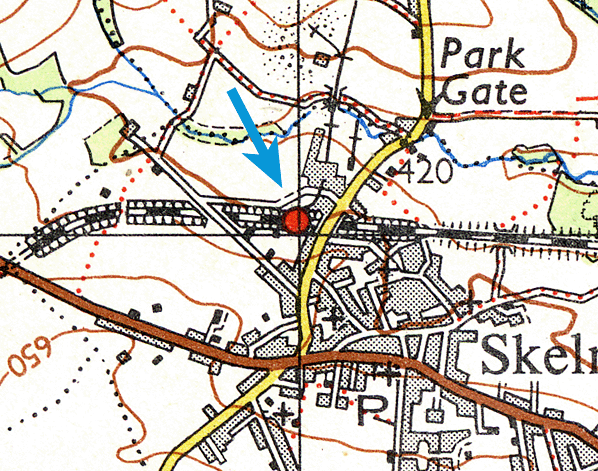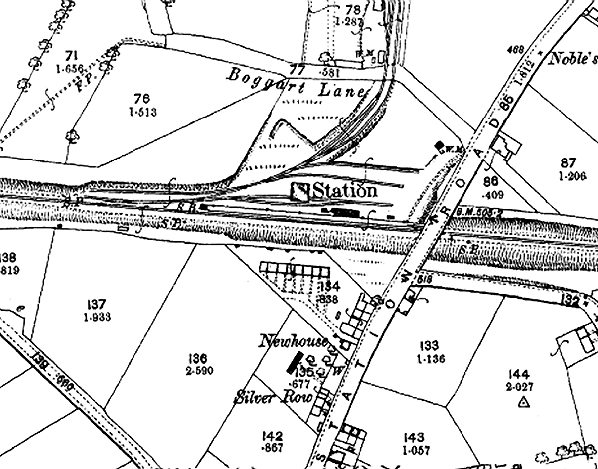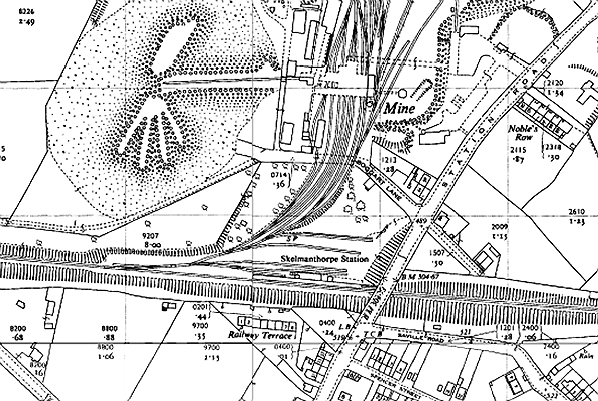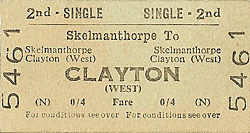
Station Name: SKELMANTHORPE[Source:
Nick Catford]
9.jpg) Skelmanthorpe station c 1908. Surprisingly the Railway Clearing House handbook for 1904 lists the station as handling only general goods and parcels. As can be seen in this picture there is a substantial timber warehouse with loaded coal wagons in three of the four sidings. Emley Moor colliery is out of site behind the goods shed. The rooms in the station building are, from left to right: Gentlemen's toilet (end of building), ladies’ waiting room, general waiting room, booking office and parcels office.
Copyright photo from John Alsop collection  
1893 1:2,500 OS map. Over the years there was little change to the layout od the station. The station signal box is seen at the west end of the platform. One siding passes through the goods shed behind the station building with a loop between the shed and the platform. A siding runs north into Emley Moor colliery with two sidings running from it into the goods yard. The entrance to the yard is seen at the junction of Boggart Lane and Station Road where a weighbridge is shown.

1960 1:2,500 OS map. By this date Emley Moor colliery had expanded with more sidings being added running north towards the colliery screens. The signal box had been demolished by this date being replaced by a two-lever ground frame at the junction. Although the goods yard remained open until 1 June 1964 the goods shed has been demolished and the loop relaid as another siding behind the platform. The platform has been shortened to two thirds of its original length and was to be further truncated before the end of the decade.
12.jpg) DMUs replaced steam on 2 January 1961, and one is seen here bound for Clayton West. The yard still handled considerable coal traffic at this time, and loaded wagons are seen in three of the sidings.
Photo from John Mann collection 10.jpg)
Passengers have just alighted from a Clayton West-bound DMU, probably in the mid 1960s. It is not clear why the platform has been truncated and no longer runs the full length of the station building in this view. A narrow section of the platform has been retained to give access to the gents' toilet which was at the far end of the building.
Photo from John Mann collection
11.jpg) A DMU waits at Skelmanthorpe after the station was downgraded to an unstaffed halt on 9 October 1966. The building looks very run-down and appears to be out of use as all the signage relating to the room has been removed. The separate building in the foreground was probably a parcels store.
Photo from John Mann collection 4.jpg) Skelmanthorpe station looking east in September 1968, the gents’ toilet is seen on the end of the building. Note the short, steep ramp added when the platform was shortened. There is apparently no signage giving the station’s name. Copyright photo from Stations UK 8.jpg) Skelmanthorpe station looking east in the early 1970s shortly after the station had been refurbished. New brick facing and a ramp at the west end were added to the platform. The former parcels shed has been repainted and converted into a waiting shelter, and BR Corporate Identity signs have been fitted. The new station lighting has not yet been installed. Photo by John Mann 22.jpg)
Skelmanthorpe goods yard in April 1982. The goods shed was between the two telegraph poles and the rear of the now-demolished west end of the platform. The signal box was at the west end of the platform. Emley Moor colliery, which was still open at this time, is out of view round the bend.
Photo by Kieth Spencer 29.jpg) Skelmanthorpe station looking east on 22 January 1983, the last day of public service.
Photo by Norman Daley  Skelmanthorpe station looking east in August 1983. The station building has been demolished and the parcels shed converted into an open-fronted waiting shelter. The platform has been refaced in brick, and a new ramp has been built at the west end. The tall electric lamp was provided in the early 1970s .
Photo by Nick Catford 19.jpg)
Skelmanthorpe station looking west in December 1983, nearly a year after closure. Emley Moor colliery was still open at this time but there is little evidence of the line being used. The points at Clayton Junction were not clamped out of use until September 1984.
Photo by Alan Young 13.jpg)
Skelmanthorpe station looking west from Station Road bridge in November 1986. The colliery is now closed and the track is out of use awaiting lifting the following year. The waiting shelter has already been demolished.
Photo by Michael Kaye 
The new Kirklees Light Railway station and passing loop at Skelmanthorpe. The locomotive is 'Fox’, the first engine built for the Railway in 1987 before the Kirklees Light Railway existed. It is a 2-6-2 tank engine, based on a Hunslet design. Despite being the oldest, 'Fox' is one of the hardest working engines on the KLR and is used both for passenger trains and driver experience courses.
Photo by Stephen Ashton  Home Page Home Page
|





new2.jpg)
